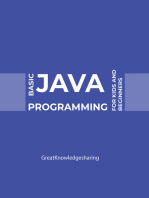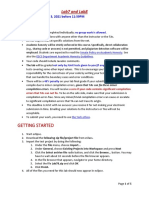Core Java 1) Basics Of Java 1) Basics of java
Uploaded by
godse.1001Core Java 1) Basics Of Java 1) Basics of java
Uploaded by
godse.1001Puneri Pattern Pvt.
Ltd
Affordable & Live Training
Address: P2 304, Pentagon Tower 2, Magarpatta City IT Park, Hadapsar, Pune 28, India. Contact:
8766016640 Email: puneripatternpvtltd@gmail.com Website: www.puneripattern.com
Core Java
Basics of Java:
WHAT IS THE NEED OF JAVA?
WHERE IT IS USED?
WHAT IS JAVA?
HISTORY OF JAVA?
Java- what , where and why.
Java technology is wide used currently. Let’s start learning of java from basic questions like what is java, where it is used, what type of application
are created in java and why use java.
What is Java?
Java is a programming language and a platform.
Platform any hardware of software environment in which a program runs, known as a platform. Since java has its own Runtime Environment
(JRE) and API, it is called platform.
Where it is used?
There are many devices where java is currently used. Some of them are as follows:
1. Desktop Application such as acrobat reader, media player, antivirus etc.
2. Web Application such as irctc.co.in.
3. Enterprise Application such as banking application.
4. Mobile
5. Embedded System.
6. Smart Card
7. Robotics
8. Games etc.
Types of Java Application:
There are mainly 4 type of applications that can be created using java:
1 Standalone Application it is also known as desktop application or window-based application. An application that we need to install on every
machine such as media player, antivirus etc. AWT andSwing are used in java for creating standalone application
2. Web Application An application that runs on the server side and creates dynamic page. Is called web application.
For Puneri Pattern Pvt. Ltd. Students Only.
Puneri Pattern Pvt.Ltd
Affordable & Live Training
Address: P2 304, Pentagon Tower 2, Magarpatta City IT Park, Hadapsar, Pune 28, India. Contact:
8766016640 Email: puneripatternpvtltd@gmail.com Website: www.puneripattern.com
Currently, servlet, jsp, struts, jsf etc. technology are used for creating web application in java.
3. Enterprise Application An application that is distributed in nature, such as banking application etc. it has the advantage of high level
security, load balancing and clustering. In java, EJB is used for creating enterprise application.
4. Mobile Application An application that is created for mobile devices. Currently Android and Java ME are used for creating mobile
application.
History of JAVA:-
Let’s see some points that describes the history of java.
James Gosling, Mike Sheridan, and Patrick Naughton initiated the java language project in June 1991.
Originally designed for small, embedded system in electronic appliances like set – top boxes
Initially called Oak and was developed as part of the Green project
In 1995, Oak was renamed as “JAVA”. Java is just name not an acronym.
Originally developed by James Gosling at Sun Microsystems(which in now a subsidiary if oracle Corporation) and released in 1995.
JDK 1.0 released in (January 23, 1996)
Java Version History:
There are many java versions that has been released.
1. JDK Alpha and Beta (1995)
2. JDK 1.0(23rd Jan, 1996)
3. JDK 1.1(19th Feb, 1997)
4. J2SE 1.2(8th Dec, 1998)
5. J2SE 1.3(8th May, 2000)
6. J2SE 1.4 (6th Feb, 2002)
7. J2SE 5.0(30th Sep, 2004)
8. Java SE 6 (11th Dec, 2006)
9. Java SE 7 (28th July, 2011)
10. Java SE 8 March 2014.
11. Java SE 9 At JavaOne 2011, Oracle discussed features they hope to have in a 2016 release of Java 9.
The Basic Types Of Java:
Core Java
Advance Java
Mobile Java
J2SE JAVA 2 STANDARD EDITION
J2EE JAVA 2 ENTERPRISE EDITION
J2M3 JAVA 2 MICRO EDITION
For Puneri Pattern Pvt. Ltd. Students Only.
Puneri Pattern Pvt.Ltd
Affordable & Live Training
Address: P2 304, Pentagon Tower 2, Magarpatta City IT Park, Hadapsar, Pune 28, India. Contact:
8766016640 Email: puneripatternpvtltd@gmail.com Website: www.puneripattern.com
Java Development Kit (JDK)
The “JDK” is the java Development Kit. i.e. , the JDK is bundle of software that you can use to develop java based software.
Each JDK contains one (or more) JRE’s along with the various development tools like the java source compilers, bundling and development tools,
debuggers, development libraries, etc.
Java Run time Environment(JRE)
The java Runtime Environment (JRE) provides the libraries, the java virtual machine, and other components to run applets and applications
written in the java programming language.
Java Virtual Machine(JVM)
The Java Virtual Machine is responsible for the hardware and operating system independence of the java SE platform, the small size of compiled
code (bytecode), and platform security.
A java compiler compiles source files (.java) to bytecode files (.class). Sun gives developers a free java compiler which is invoked with
the ‘javac’ command.
A java interpreter is usually referred to as the Java Virtual Machine (or JVM). It reads and executes the bytecodes in the .class files (or
.
in some collection of class files, like a zipor .jar file). Sun also supplies a free version of the JVM which is invoked with the ‘java’
command.
Where is gets confusing is when people talk about a Just-In-Time compiler (or JIT compiler). This is actually part of a JVM. Its purpose
is to take the generic (i.e. cross-platform) bytecodes and compile them into more machine-specific instructions (allowing the program
.
to run significantly faster). Even though it is referred to as a JIT ‘compiler’, it is part of the Virtual Machine
For Puneri Pattern Pvt. Ltd. Students Only.
You might also like
- Understanding Stuck Messages (Addendum) : Paul O'Donnell and Ty ShrakeNo ratings yetUnderstanding Stuck Messages (Addendum) : Paul O'Donnell and Ty Shrake44 pages
- Core Java Full Notes by kiran @satya technologiesNo ratings yetCore Java Full Notes by kiran @satya technologies368 pages
- Mahakal Institute of Technology Ujjain Madhya Pradesh: Department of Computer Science and EngineeringNo ratings yetMahakal Institute of Technology Ujjain Madhya Pradesh: Department of Computer Science and Engineering26 pages
- What Is Java ?: Platform: Any Hardware or Software Environment in Which A Program Runs, Is Known AsNo ratings yetWhat Is Java ?: Platform: Any Hardware or Software Environment in Which A Program Runs, Is Known As8 pages
- Java Example: Platform: Any Hardware or Software Environment in Which A Program Runs, Is Known As ANo ratings yetJava Example: Platform: Any Hardware or Software Environment in Which A Program Runs, Is Known As A12 pages
- 3 Introduction Histor, Appl Ed, Ver, Fea, Arch (Unit 1)No ratings yet3 Introduction Histor, Appl Ed, Ver, Fea, Arch (Unit 1)14 pages
- X-51nBc ZqYiRfoi6b EU-yLfUnMoDvnKMsAlF77FxQhGeTJiPb2nANo ratings yetX-51nBc ZqYiRfoi6b EU-yLfUnMoDvnKMsAlF77FxQhGeTJiPb2nA49 pages
- CSCP 363: Object Oriented Programming in Java INo ratings yetCSCP 363: Object Oriented Programming in Java I14 pages
- Core Java 1)Basics of Java 4)JDK,JRE _ JVMNo ratings yetCore Java 1)Basics of Java 4)JDK,JRE _ JVM4 pages
- Concurrent Programming in Java Design Principles ANo ratings yetConcurrent Programming in Java Design Principles A216 pages
- Com - Cherisher.beauty - Camera.videocall LogcatNo ratings yetCom - Cherisher.beauty - Camera.videocall Logcat58 pages
- SOFTWARE_FOR_SIZING_PAD-FAN_EVAPORATIVE_COOLING_SYNo ratings yetSOFTWARE_FOR_SIZING_PAD-FAN_EVAPORATIVE_COOLING_SY12 pages
- Cse229: Programming in Java: Through This Course Students Should Be Able ToNo ratings yetCse229: Programming in Java: Through This Course Students Should Be Able To2 pages
- Catchlogs - 2023-12-24 at 23-09-16 - 7.60.1 - .JavaNo ratings yetCatchlogs - 2023-12-24 at 23-09-16 - 7.60.1 - .Java54 pages

























































































